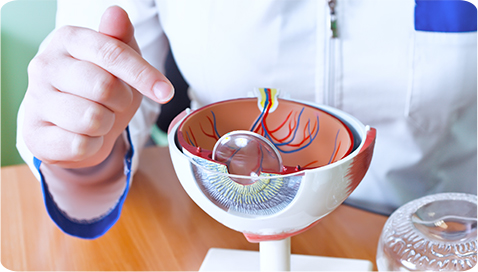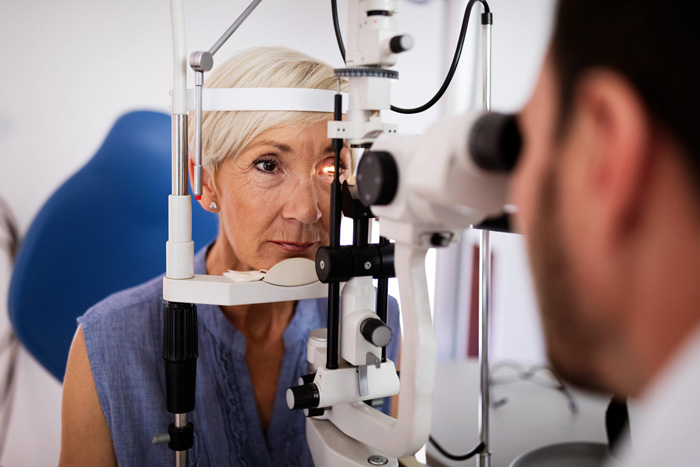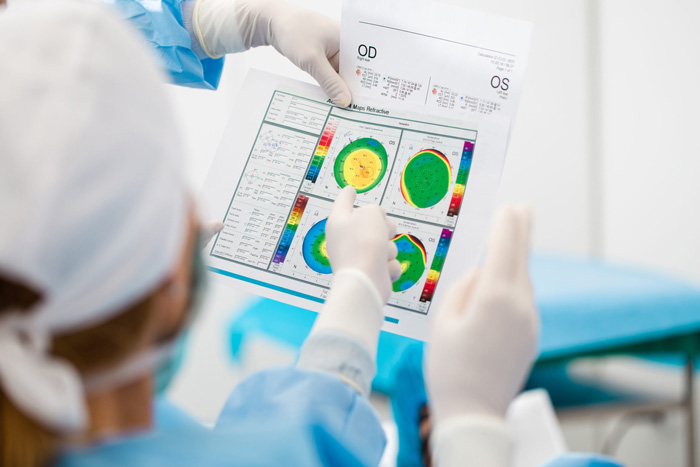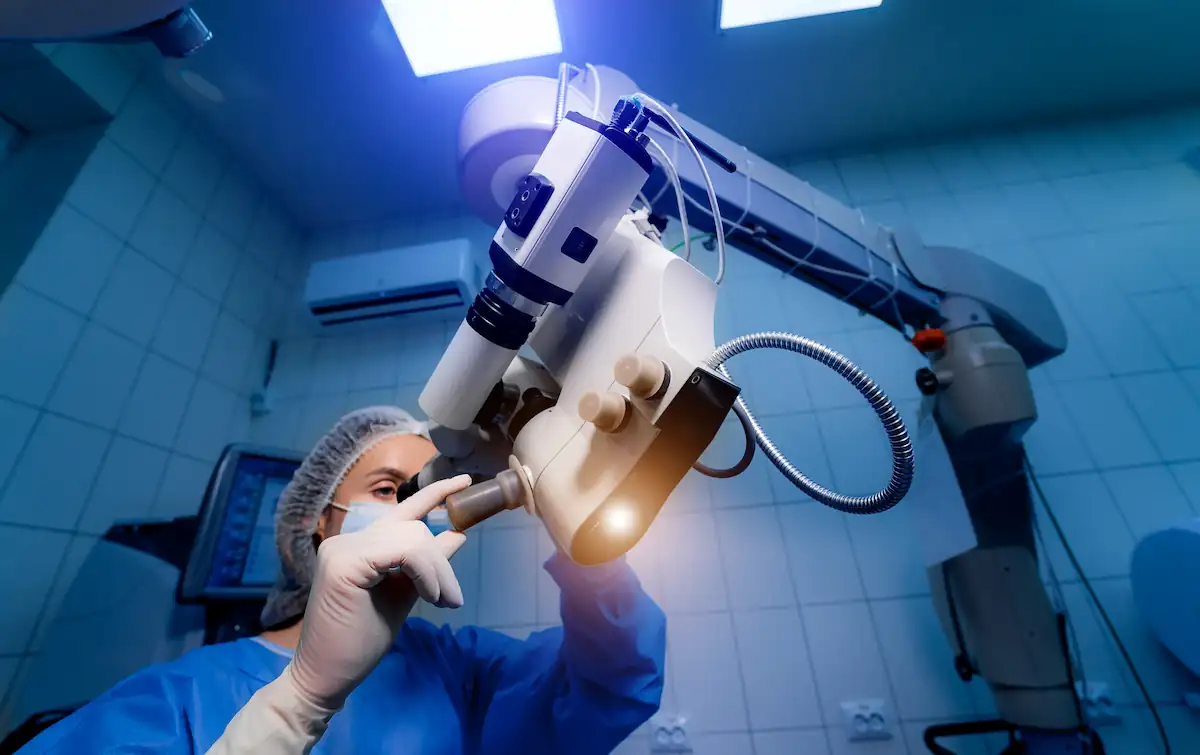Cataract Surgery
Your lifestyle, your vision, your freedom.
Your lifestyle, your vision, your freedom.
At K2 Vision, we believe in empowering patients with clearer sight—and the freedom that comes with it. Whether you’re in Seattle, Portland, the Tri-Cities, Tacoma, Olympia, Vancouver, Everett, or Scottsdale/Phoenix, our experienced team is here to guide you through every step of the cataract surgery process. With modern technology, unmatched surgical experience, and a patient-first approach, we’re redefining what it means to see clearly.
As a practice solely focused on vision correction, our goal is to provide advanced solutions that improve not only your sight but your overall eye health.

What are Cataracts?
Cataracts are a normal part of the aging process and one of the leading causes of vision problems worldwide.
The natural lenses of the eye are clear, but the proteins in them begin to harden around age 40 (Stage 1 of a Dysfunctional Lens). Over time, these proteins clump together and cloud the lens—this is a cataract (Stage 2 of a Dysfunctional Lens).
As the lens becomes increasingly clouded, it blocks or distorts light entering the eye. This leads to symptoms such as blurry vision, increased glare, halos around lights, and difficulty seeing in low light and distorting natural colors. Without treatment, cataracts continue to progress—gradually interfering with your daily life.
Cataracts may also develop faster in patients with certain eye conditions like glaucoma or diabetic retinopathy.
According to the National Eye Institute, up to 50% of Americans will develop at least one cataract by the age of 75.1
Ready to repair your vision?
Schedule your virtual consultation right now to find out if you are a candidate for cataract surgery.
Symptoms of Cataracts
Cataracts develop gradually, and early signs can be subtle. Common symptoms include:
- Blurry or dim vision
- Increased sensitivity to light and glare
- Halos around lights, especially at night
- Faded or yellowed colors
- Double vision in one eye
- Frequent changes in eyeglass or contact lens prescriptions
- Some patients may notice difficulty with near vision or distance vision, making everyday tasks more challenging.2
Once cataract symptoms interfere with daily activities like driving, it is time for cataract surgery.
How Cataract Surgery Works
Cataract surgery is the only way to remove a cataract. During this outpatient procedure, your eye surgeon removes the clouded natural lens and replaces it with a clear artificial intraocular lens (IOL). This artificial lens restores vision—and often improves it beyond what you had before. Most patients are in and out of the clinic within a few hours and enjoy clearer vision almost immediately.
Standard vs Custom Cataract Surgery
Standard Cataract Surgery
Standard Cataract Surgery involves implanting a monofocal IOL that provides clear vision at a single distance. It’s highly effective but may require you to wear glasses for reading or intermediate tasks.
Custom Cataract Surgery
Custom Cataract Surgery is a more advanced approach. Using detailed diagnostics, your eye surgeon selects a premium IOL—such as a multifocal or toric lens—to address your specific vision needs. This tailored solution reduces your dependence on glasses and gives you more freedom.
Your ophthalmologist will guide you through the best options based on your ocular anatomy and lifestyle needs.
Explore Your IOL Options
Light Adjustable Lens™ (LAL)
The only lens that can be fine-tuned after surgery using a series of light-based treatments. K2 Vision is the #1 provider of LALs in the U.S. This technology delivers customized results and predictive outcomes based upon a large data set—especially ideal for patients with complex prescriptions or prior LASIK.
Monofocal IOLs
The traditional option, offering excellent clarity at one distance. Monovision setups (one eye for near, one for distance) are also possible.
We’ll help you compare each type of IOL to find the one that supports your clearest, most functional vision.
Multifocal IOLs
These lenses provide focus at multiple distances—near, intermediate, and far—reducing or eliminating the need for glasses.
Toric IOLs
Designed to correct astigmatism, toric lenses provide sharper vision by addressing irregular corneal curvature.
“With the Light Adjustable Lens, we’re no longer limited to best guesses—we’re delivering customized vision based on how your eyes actually respond. It’s a game-changer.”
Why Choose K2 Vision?
#1 in LAL
K2 Vision is the top practice in the U.S. for Light Adjustable Lenses.
Data-Driven Outcomes
We use advanced diagnostics and past patient data to predict your results with clarity.
Patient-First Care
No rushed consults or one-size-fits-all recommendations—just honest guidance tailored to your goals.
Vision-Correction Focus
A practice dedicated exclusively to modern vision correction with premium lens implants designed to eliminate the need for glasses.
Our team of ophthalmologists and support staff specialize in delivering outcomes that protect both vision and long-term eye health.
Preparing for Cataract Surgery
Your journey begins with a free, no-pressure consultation where our team takes the time to understand your vision goals and evaluate your overall eye health. During this visit, we’ll:
- Conduct advanced diagnostic imaging of your eyes, including measurements of your cornea, lens, and eye surface
- Evaluate the retina and screen for eye diseases like glaucoma to ensure you’re a good candidate.
- Review your medical history and current eyewear or contact lens use
- Discuss lifestyle factors like reading habits, screen time, and hobbies
- Talk through all available IOL options—including monofocal, multifocal, toric, and Light Adjustable Lenses—so you can make an informed choice
Note: If you wear contact lenses, we may ask you to stop wearing them for a few days before your evaluation, as they can temporarily affect the shape of your cornea.
We’ll also go over what to expect before and after surgery, answer all your questions, and provide detailed pre-op instructions tailored to you.
The Cataract Surgery Procedure
Cataract surgery is a quick and highly effective procedure:
- You’ll arrive at our clinic and receive numbing eye drops and a mild sedative.
- Your surgeon will make a small incision and use phacoemulsification to gently remove the cloudy lens.
- Your chosen intraocular lens (IOL) will be inserted and securely placed inside the lens capsule.
- You’ll go home the same day with protective eyewear and detailed postoperative instructions with a designated driver.
- An eye shield may be provided to wear during sleep to protect the healing eye.
Recovery After Cataract Surgery
Recovery is typically smooth:
- You’ll use eye drops to prevent infection and control inflammation.
- Most people return to normal activities within 24–48 hours.
- If you received the Light Adjustable Lens, your vision will be fine-tuned over a 6–8 week period using noninvasive light treatments.
- Follow-up visits ensure your eye is healing and vision is progressing as expected.
What surprises patients most is not just how quick the procedure is—but how fast they see results. For many, it’s like turning the lights back on.
FAQs About Cataract Surgery
Is cataract surgery covered by Medicare?
Yes. Standard cataract surgery with a monofocal lens is typically covered. There may be additional costs associated with the type of lens you select.
How much does cataract surgery cost?
The cost of cataract surgery can vary depending on your insurance coverage and the type of intraocular lens (IOL) you choose. While standard cataract surgery is typically covered by Medicare and most insurance plans, advanced lenses like multifocal or Light Adjustable Lenses may involve additional out-of-pocket expenses. At K2 Vision, we offer flexible financing options to help make your vision goals more accessible—our team will walk you through all costs and coverage details during your consultation.
Does cataract surgery treat astigmatism?
Yes—with toric or Light Adjustable Lenses, we can correct astigmatism during the procedure.
Is the procedure painful?
No. Cataract surgery is performed using numbing eye drops and light sedation—you won’t feel discomfort.
What are the risks?
Can I have cataract surgery after LASIK?
Absolutely. Our team regularly performs cataract surgery on patients with a history of LASIK, PRK, or RK.
Will I still need glasses?
Depending on your IOL choice, you may reduce or eliminate the need for eyeglasses or reading glasses.
How long does it take to heal?
Vision often improves within a day. Full stabilization may take a few weeks, especially with Light Adjustable Lenses.
Can cataracts come back?
No, once a cataract is removed, it cannot come back. However, some patients may experience blurry vision months or even years after surgery due to a condition called posterior capsular opacification (PCO)—sometimes referred to as a “secondary cataract.” PCO occurs when the thin membrane (or capsule) that holds your new lens becomes cloudy over time.
Fortunately, it’s easily treated with a quick, painless laser procedure called a YAG laser capsulotomy. This in-office treatment takes only a few minutes and restores clear vision without the need for incisions or additional recovery time.
Contact Us
Ready to rediscover life without cloudy vision?
Book a free consult in Seattle, Tacoma, Olympia, Everett,
Portland, the Tri-Cities, Vancouver, or Scottsdale/Phoenix.
Schedule today and start your custom-tailored vision journey today.
K2 Vision. Freedom from glasses, contacts—and cataracts.
1 National Eye Institute. Cataract Data and Statistics. Available: https://www.nei.nih.gov/learn-about-eye-health/outreach-campaigns-and-resources/eye-health-data-and-statistics/cataract-data-and-statistics. Accessed July 7, 2025.
2 Cleveland Clinic. Cataracts. Available: https://my.clevelandclinic.org/health/diseases/8589-cataracts. Accessed July 7, 2025.
3 American Refractive Surgery Council. Is Cataract Surgery with Vision-Correcting IOLs Safe? Available: https://americanrefractivesurgerycouncil.org/refractive-surgery-procedures/cataract-surgery-with-vision-correcting-iols/is-cataract-surgery-with-vision-correcting-iols-safe. Accessed July 7, 2025.




